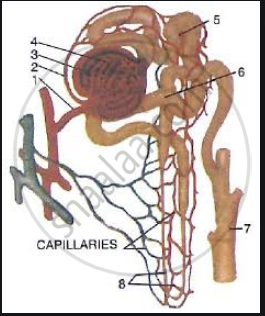Advertisements
Advertisements
Question
Match structures given in Column I with functions given in Column II.
| Column I | Column II | ||
| (i) | Stomata | (a) | Absorption of water |
| (ii) | Xylem | (b) | Transpiration |
| (iii) | Root hairs | (c) | Transport of food |
| (iv) | Phloem | (d) | Transport of water |
| (e) | Synthesis of carbohydrates |
Solution
| Column I | Column II | ||
| (i) | Stomata | (b) | Transpiration |
| (ii) | Xylem | (d) | Transport of water |
| (iii) | Root hairs | (a) | Absorption of water |
| (iv) | Phloem | (c) | Transport of food |
APPEARS IN
RELATED QUESTIONS
Draw a diagram of the human excretory system and label the various parts.
The form in which glucose in stored in liver.
A dialysis machine contains long tubes coiled in a tank containing dialysing solution
What does the dialysing solution contain?
Describe the mechanism of urine formation in human excretory system. Draw a labelled diagram to illustrate your answer.
Answer the following in detail.
Describe the process of urine formation.
Define the following term:
Micturition
The following diagram represents a mammalian kidney tubule (nephron) and its blood supply.

Parts indicated by the guidelines 1to 8 are as follows:
1. Afferent arteriole from renal artery
2. Efferent arteriole
3. Bowman's capsule
4. Glomerulus
5. Proximal convoluted tubule with blood capillaries
6. Distal convoluted tubule with blood capillaries
7. Collecting tubule
8. U-shaped loop of Henle
Study the diagram and answer the question that follow:
Which structure contains the lowest concentration of urea?
Complete the following sentence with appropriate word:
The U-shaped portion of a nephron located in the medulla region is called ______.
The process of diffusion of solvent particles from the region of less solute concentration to a region of high solute concentration through a semi-permeable membrane is known as ____________.
The main nitrogenous waste formed in the human body:
